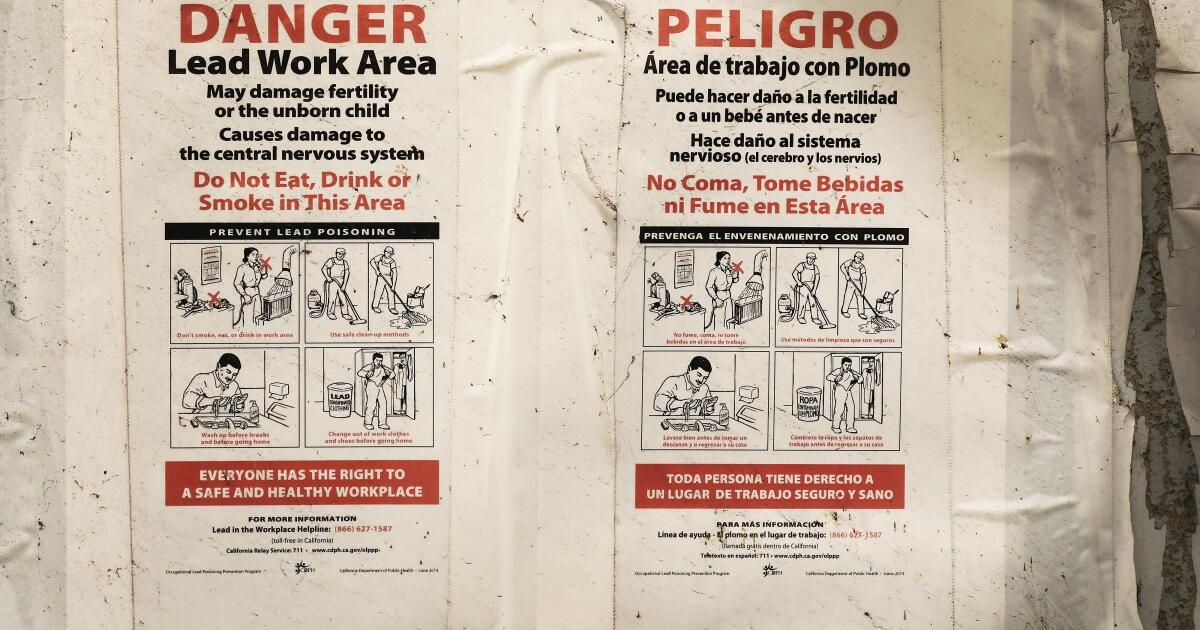For the first time in decades, California is tightening its rules on workplace exposure to lead, a poisonous metal that can wreak havoc throughout the body.
Experts said the new regulations will make California a national leader in combating the insidious and deadly effects of lead in the workplace.
The California Occupational Safety and Health Standards Board voted 5-2 Thursday to adopt the rules despite objections from business groups who said they were unworkable and difficult to understand.
“The evidence is undeniable that even small levels of exposure can have very, very serious effects,” board member Joseph M. Alioto Jr. said before voting to update the regulations.
It is undeniable that even small levels of exposure can have very, very serious effects.
— Joseph M. Alito Jr., member of the California Occupational Safety and Health Standards Board
Supporters said stricter requirements were needed in light of evidence that workers could suffer health risks, such as kidney dysfunction or hypertension, from amounts of lead far below what California had allowed.
So far, failure to act on that scientific evidence “means that an unknown number of lead-exposed workers have died prematurely from heart disease” or suffered other harm, said Barbara Materna, former chief of occupational health at the California Department of Public Health. . “We cannot allow more decades to pass before we take a step forward.”
According to Cal/OSHA, the new standards aim to keep blood lead levels below 10 micrograms per deciliter, instead of the previously established goal of 40 micrograms.
The regulations will take effect in January, with an additional year for companies to implement some of the requirements.
The vote comes more than a decade after the state public health department recommended that labor regulators review their lead rules to better protect workers. California's existing limits are the same as the federal standard, but public health officials said they were based on scientific findings that are now more than four decades old.
“The rule became outdated as our knowledge of the harms associated with lower levels of lead exposure developed,” said Dr. Michael Kosnett, a medical toxicologist at the Colorado School of Public Health.
Inside the human body, lead acts as a calcium double and disrupts important molecular functions when it replaces the mineral, said Dr. Howard Hu, a USC preventive medicine specialist.
Lead “accelerates many of the body's processes related to aging,” increasing the risk of heart attacks, Hu said. And in the brain, it interferes with connections between brain cells, resulting in “fuzzy thinking.”
The dangers to babies and young children are widely known and particularly serious (including slower development and learning problems), but adults can be at risk too.
Although lead can kill people in a matter of days in high enough doses, it is often a more pernicious threat, slowly damaging the brain, heart, kidneys and other body systems over years and even decades. It can cause impotence and sterility in men and threaten the fetus if a pregnant person is exposed.
Workers may not know that their health has been affected by lead, but “it ends up settling into the bones and slowly leaches out throughout their lives,” said Dr. Robert Blink, former president of the Association. Western Environmental and Occupational Medicine. Doing so “causes heart disease, kidney disease, stroke, and premature death.”
The new standards lower the exposure limit for lead in air, reducing it from 50 micrograms to 10 micrograms per cubic meter for most workers.
The rules also lower the “action level,” a trigger for workplaces to take action. measures such as periodically checking blood lead levels: from 30 micrograms to 2 micrograms per cubic meter of air.
Employers are supposed to change their workplace settings and procedures to reduce airborne exposure as much as possible. But if measures such as improving ventilation and dust control do not bring lead levels below the state limit, employees must also be protected with respirators.
Lead can be a hazard to a variety of workers, including workers involved in recycling or manufacturing lead-acid batteries; construction workers performing abrasive blasting, steel welding, or lead abatement; and employees at shooting ranges.
Under existing California rules, if a worker reaches a high enough blood lead level, he or she must be temporarily removed from work that causes exposure and given additional medical examinations or testing, all without losing income or other rights. labor. The new requirements lower the bar for adopting these types of measures.
Industry groups pushed for the state to take another step to update the rules, saying the plan was neither reasonable nor clear. Many argued that facilities that followed the old air lead rules could keep their workers' blood lead levels below the target level.
The rules “are going to be incredibly burdensome and costly for the industry, ours and many other industries,” said Roger Miksad, president and CEO of Battery Council International, a trade association representing battery manufacturers and recyclers. “You can get that blood [lead levels] “no draconian changes to air lead requirements.”
Marc Connerly, executive director of the Roofing Contractors Association. of California, said the new stimulus for employers to take action is “so unreasonably low” that many companies will not understand the rationale for the stricter requirements and “will simply scoff at it.”
Board member Chris Laszcz-Davis, who voted against the new rules, expressed concern about whether they were understandable or enforceable. “If we're going to set a standard where everyone scratches their head and says, 'Here we go again,' we're going to see noncompliance,” he said.
Environmental and workplace safety advocates rejected the idea that the new limit on lead in air was unnecessary. The California Department of Public Health identified more than 2,100 workers between 2019 and 2022 with blood lead levels higher than the new rules are intended to allow — more than 5% of those who were tested.
Those numbers “tell us that some people are overexposed,” said Rania Sabty, an environmental health scientist. Limiting lead levels in the air is important because “in public health, we prevent exposure at the source in the first place. “We don’t wait for it to damage the body and then try to do something about it.”
The new regulations set higher allowable limits for lead in air for some processes used to manufacture and recycle lead-acid batteries. Even in those cases, employers are supposed to keep lead exposure below the limit of 10 micrograms per cubic meter by using respirators to protect workers.
State regulators estimated the new rules would save $37.9 million in the first year alone by reducing costs associated with lead-related illnesses and premature deaths. Annual savings are projected to increase each year, reaching $1.7 billion after 45 years. Cal/OSHA officials said clamping down on lead for workers will have a beneficial ripple effect on others, including reducing children's exposure when adults accidentally bring lead dust into their homes.
Compliance with the new rules is estimated to cost private companies about $230 million a year, including expenses for medical surveillance, air monitoring and personal protective equipment, according to regulators. Industry Representatives disputed that estimate, saying costs had been drastically underestimated and that small businesses would be hurt by the additional spending.
Lead exposure for the average person in the United States has plummeted since the 1970s, when the metal was removed from gasoline, house paint and other common items. But even as progress was made, scientists learned that lead can be dangerous at lower levels than previously thought, Hu said.
“There is no level of lead exposure that is known to be safe, especially for children,” Blink said.
Even if the new rules manage to keep workers' blood lead levels below the state goal, they may still be at risk for hypertension, increased blood pressure and decreased kidney function at lower levels, researchers have found. scientists. The state's public health department had recommended a much lower limit for lead in air than the one approved Thursday.
Cal/OSHA staff members said they considered a stricter limit but decided against it because the costs to businesses would be much higher and the additional benefits were unclear.












